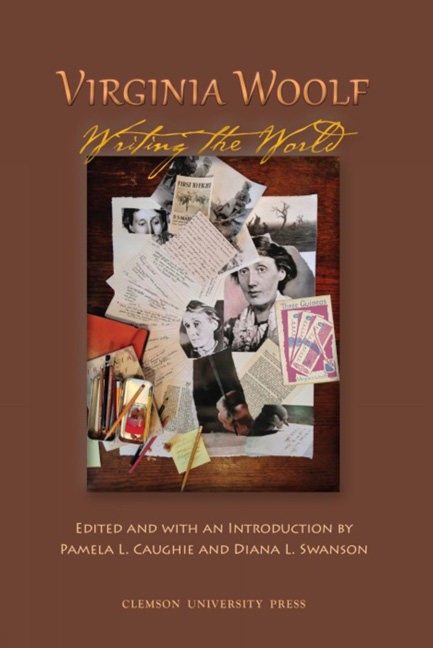Book contents
- Frontmatter
- Table of Contents
- Introduction
- Acknowledgmen
- Abbreviation
- WAR AND PEACE
- WORLD WRITER(S)
- ANIMAL AND NATURAL WORLD
- “And the donkey brays”: Donkeys at Work in Virginia Woolf
- Companion Creatures: “Dogmanity” in Three Guineas
- Virginia Woolf's Object-Oriented Ecology
- The Bodies In/Are The Waves
- Stretching our “Antennae”: Converging Worlds of the Seen and the Unseen in “Kew Gardens”
- “The Problem of Space”: Embodied Language and the Body in Nature in To the Lighthouse
- “Whose Woods These Are”: Virginia Woolf and the Primeval Forests of the Mind
- WRITING AND WORLDMAKING
- Notes on Contributors
- Conference Program
- Appendix: Virginia Woolf Conference Exhibit Items, Newberry Library
Companion Creatures: “Dogmanity” in Three Guineas
from ANIMAL AND NATURAL WORLD
- Frontmatter
- Table of Contents
- Introduction
- Acknowledgmen
- Abbreviation
- WAR AND PEACE
- WORLD WRITER(S)
- ANIMAL AND NATURAL WORLD
- “And the donkey brays”: Donkeys at Work in Virginia Woolf
- Companion Creatures: “Dogmanity” in Three Guineas
- Virginia Woolf's Object-Oriented Ecology
- The Bodies In/Are The Waves
- Stretching our “Antennae”: Converging Worlds of the Seen and the Unseen in “Kew Gardens”
- “The Problem of Space”: Embodied Language and the Body in Nature in To the Lighthouse
- “Whose Woods These Are”: Virginia Woolf and the Primeval Forests of the Mind
- WRITING AND WORLDMAKING
- Notes on Contributors
- Conference Program
- Appendix: Virginia Woolf Conference Exhibit Items, Newberry Library
Summary
Dogs have played such an integral part in human cultural history that the eighteenth-century novelist Hugh Walpole thought our species might more accurately be dubbed “dogmanity,” so inseparable is our evolution from that of canines (qtd. in McHugh 171). As Susan McHugh explains in Dog, the Canis familiaris is ubiquitous in human communities: dogs’ ready availability, remarkable adaptability to extreme conditions, loyalty, and tractability explain their prominence in human households, exploration, and scientific research (171–72). Yet that co-evolutionary story has not been without its tensions. We might remember the turmoil of the Brown Dog Riots in London around that watershed year 1910, when a brown terrier that had been the cruel victim of vivisection in the laboratories of University College gained public sympathy and, temporarily, a memorial statue in Battersea Park (McHugh 138–89; Goldman 60–3). Before its removal, the statue, with a fountain for humans and dogs, attracted a surprising coalition of defenders, including suff ragists, organized male workers, and animal welfare advocates, all united in their opposition to the torture of one species for the sake of another's epistemological quest. We might read in the eff orts of this impromptu coalition to preserve the short-lived statue early evidence of Woolf's Outsider's Society.
Drawing upon the work of Marshall McLuhan, Tom Tyler argues that “the dog was, originally, a primordial technology that functioned as an extension of human capacities and thereby made possible a whole new way of life” (76). In the laboratory as in the household, humanity has looked to dogs as prostheses, sensory and perceptual technologies through which it might extend its awareness or enlarge its scope of action. In much the same way, Three Guineas (1938) shows us how the sisters and daughters of educated men have been cultivated to flourish alongside and to support their male companions. The woman as pet functions as property to shore up the privileged position of a solitary master, a symbolic prosthetic or supplement to the at once masculine and humanistic project of self-definition, esteem, and empowerment.
The nation's somewhat embarrassed reliance on a female labor force during the First World War provoked a misogynistic backlash in the daily papers that Woolf takes pains to document.
- Type
- Chapter
- Information
- Virginia Woolf: Writing the World , pp. 141 - 147Publisher: Liverpool University PressPrint publication year: 2015

